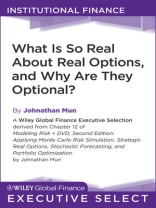In the past, corporate investment decisions were cut and dried. Buy a new machine that is more efficient, make more products costing a certain amount, and if the benefits outweigh the costs, execute the investment. Hire a larger pool of sales associates, expand the current geographical area, and if the marginal increase in forecast sales revenues exceeds the additional salary and implementation costs, start hiring. Need a new manufacturing plant? Show that the construction costs can be recouped quickly and easily by the increase in revenues the plant will generate through new and improved products, and the initiative is approved.
However, real-life business conditions are a lot more complicated. Your firm decides to go with an e-commerce strategy, but multiple strategic paths exist. Which path do you choose? What are the options you have? If you choose the wrong path, how do you get back on the right track? How do you value and prioritize the paths that exist? You are a venture capitalist firm with multiple business plans to consider. How do you value a start-up firm with no proven track record? How do you structure a mutually beneficial investment deal? What is the optimal timing to a second or third round of financing?
This chapter provides a novel approach to applying real options to answering these issues and more.
Table des matières
Preface.
What’s New in the Second Edition.
Acknowledgments.
About the Author.
Introduction.
PART ONE: Risk Identification.
CHAPTER 1: Moving Beyond Uncertainty.
PART TWO: Risk Evaluation.
CHAPTER 2: From Risk to Riches.
CHAPTER 3: A Guide to Model-Building Etiquette.
PART THREE: Risk Quantification.
CHAPTER 4: On the Shores of Monaco.
CHAPTER 5: Test Driving Risk Simulator.
CHAPTER 6: Pandora’s Toolbox.
PART FOUR: Industry Applications.
CHAPTER 7: Extended Business Cases I: Pharmaceutical and Biotech
Negotiations, Oil and Gas Exploration, Financial Planning with
Simulation, Hospital Risk Management, Risk-Based Executive
Compensation Valuation, and Risk-Based Schedule Planning.
PART FIVE: Risk Prediction.
CHAPTER 8: Tomorrow’s Forecast Today.
CHAPTER 9: Using the Past to Predict the Future.
PART SIX: Risk Diversification.
CHAPTER 10: The Search for the Optimal Decision.
CHAPTER 11: Optimization Under Uncertainty.
PART SEVEN: Risk Mitigation.
CHAPTER 12: What Is So Real About Real Options, and Why Are They
Optional?
CHAPTER 13: The Black Box Made Transparent: Real Options Super
Lattice Solver Software.
PART EIGHT: More Industry Applications.
CHAPTER 14: Extended Business Cases II: Real Estate, Banking,
Military Strategy, Automotive Aftermarkets, Global Earth
Observation Systems, Employee Stock Options, Oil and Gas Royalty
Lease Negotiations, Real Options and IT Enterprise Risk Security,
Basel II Credit and Market Risk Analysis, and IT Information
Security Intrusion Risk Management.
PART NINE: Risk Management.
CHAPTER 15: The Warning Signs.
CHAPTER 16: Changing a Corporate Culture.
Notes.
Tables You Really Need.
Answers to End of Chapter Questions.
About the DVD-ROM.
Index.
A propos de l’auteur
JOHNATHAN MUN, Ph D, is the founder and CEO of Real Options Valuation, Inc., and the creator of the Real Options Super Lattice Solver software for real options valuation, Monte Carlo Risk Simulator, and multiple other analytics software tools. Prior to starting his own firm, he was the vice president of analytics at Oracle/Crystal Ball. Mun is also a full professor at the U.S. Naval Postgraduate School (California) and the University of Applied Sciences (Switzerland and Germany). He has authored numerous books, including Real Options Analysis, Real Options Analysis Course, Advanced Analytical Models, Applied Risk Analysis, Modeling Risk, and Valuing Employee Stock Options (all published by Wiley), as well as coauthored The Banker’s Handbook on Credit Risk. Mun has also taught and consulted for over 500 corporations in thirty countries worldwide and is considered a leading authority on risk analysis and real options.












